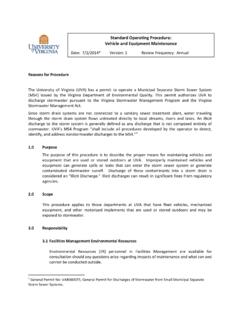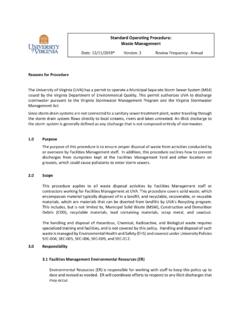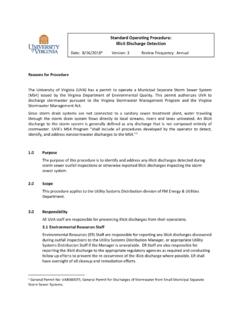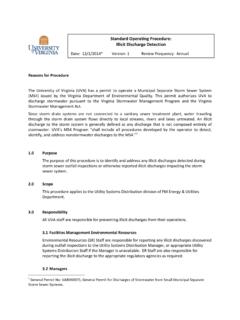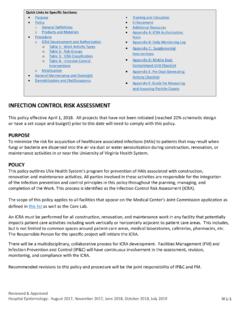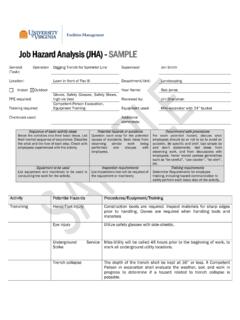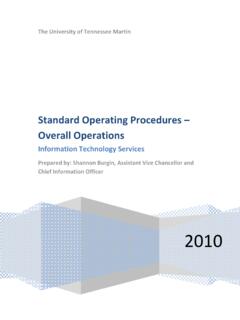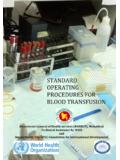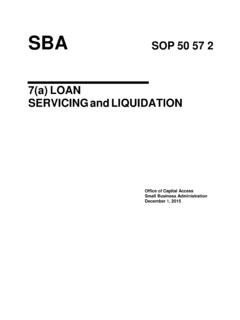Transcription of Standard Operating Procedure: Used Oil Disposal
1 Reasons for Procedure The University of Virginia (UVA) has a permit to operate a Municipal Separate Storm Sewer System (MS4) issued by the Virginia Department of Environmental Quality. This permit authorizes UVA to discharge stormwater pursuant to the Virginia Stormwater Management Program and the Virginia Stormwater Management Act. 1 As an operator which is required to have a Spill Prevention Control and Countermeasures (SPCC) plan due to the quantity of stored fuel oil, the University must abide by the applicable Federal Oil Pollution Prevention regulations.
2 Oils are used in a wide variety of job functions at UVA. This SOP has been developed to prevent the discharge of used oils into the storm sewer system, to promote safe work and responsible practices, and to comply with regulatory policies. For accidental oil releases or spills, refer to the UVA Spill Prevention Control and Countermeasures Plan. Purpose Oils are defined as greasy, viscous substances from plant, animal, mineral sources (petroleum), and synthetics that are not soluble in water, and are usually flammable.
3 These oils which have been used could be contaminated by physical or chemical impurities such as dirt, metal scrapings, and water. Oils that enter storm drains or waterways are a serious environmental hazard. One gallon of used oil can pollute 1,000,000 gallons of fresh water. The purpose of this procedure is to describe the proper means for handling and disposing of used oil from equipment maintenance operations , process procedures , and any other activities where used oils are generated.
4 Scope This procedure applies to the Disposal of any used oil that is collected during normal work functions at UVA. used oil may include: 1. Gasoline. Volatile, flammable, it can be ignited by sparks and flames even at cold temperatures. Vapors can migrate to distant ignition sources and in poorly ventilated spaces, can accumulate to explosive levels. Typical gasoline contains about 150 different chemicals including benzene, toluene and xylene.
5 1 General Permit No: VAR040073, General Permit for Discharges of Stormwater from Small Municipal Separate Storm Sewer Systems. Standard Operating Procedure: used Oil Disposal Date: 11/18/2014* Version: 1 Review Frequency: Annual used Oil Disposal Page 2 2. Fuel oils. Fuel oils such as diesel fuel are petroleum based fluids which are somewhat volatile and flammable and can be ignited only when heated above 100F.
6 Vapors can travel and flash from ignition sources and can accumulate to explosive levels in poorly ventilated areas. All fuel oils consist of complex mixtures of aliphatic and aromatic hydrocarbons such as kerosene, benzene, and styrene. 3. Lubricating oils. Lubricating oils such as motor oil and hydraulic fluids are not volatile but are combustible. For lubricating oil to catch fire some other intense heat source ( , other materials on fire, hot engine manifold, etc.)
7 Must be present. Mineral-based lube oils are refined from petroleum or crude oil and contain additives such as lead or metal sulphide and other polymers. 4. Transformer oil. Transformer oil conducts heat away from and insulates equipment used to convert electricity from high amperage to low amperage lines. Transformer oil is a liquid by-product of the distillation of petroleum to produce gasoline. 5. Cooking oils and grease. Cooking oils and grease are not volatile but they are combustible.
8 With a 400F flashpoint, another heat source must be present for cooking oils or grease to catch fire. Vegetable oils contain soy esters which can form solvents that are strong enough to dissolve engine seals and UVA Dining (Aramark) has a specialized used Cooking Oil UVA Dining SOP that should be followed at locations operated by Armark. Note: for all other waste chemicals, please see SOP regarding used Chemical Disposal . Responsibility Facilities Management Environmental Resources The Associate Director of Environmental Resources is responsible for ensuring that employees are properly informed of and trained on how to follow these procedures .
9 Managers Managers must ensure all personnel reporting to them have received appropriate training in used oil Disposal . Managers are expected to convey proper oil Disposal requirements of this procedure to contractors if non-UVA personnel are handling used oil materials. Managers and supervisors are responsible for ensuring training is conducted with the most recent version of the SOP. Personnel Performing the Job Personnel must follow the guidelines set forth in this SOP when used oils are to be discarded.
10 If personnel are unsure if the substances to be discarded are in fact oils, they should call Environmental Health and Safety (982-4911) for instructions. In addition, refer 2 #Engine%20 Seals,%20 Gaskets%20and%20 Hoses used Oil Disposal Page 3 to the EHS web page for the Safety Data Sheet (previously known as Material Safety Data Sheet) on the particular substance for relevant information regarding Disposal .
